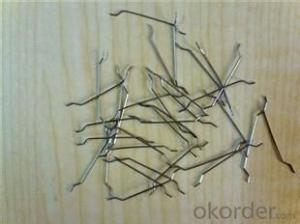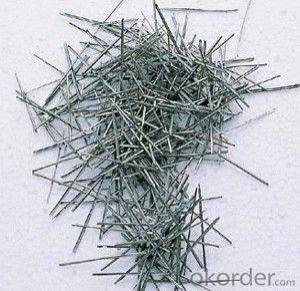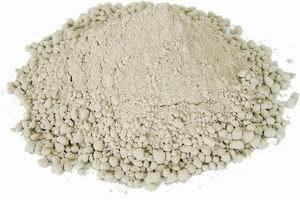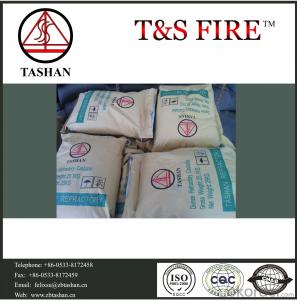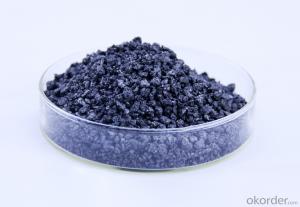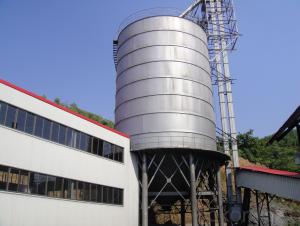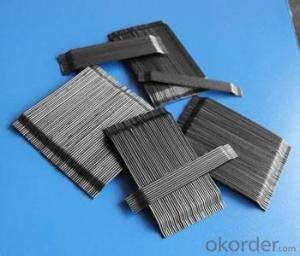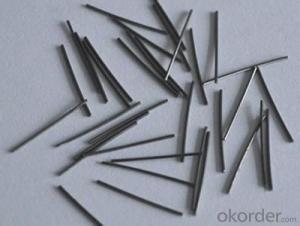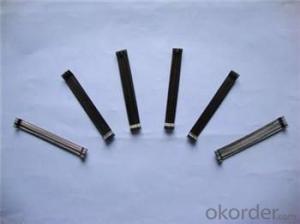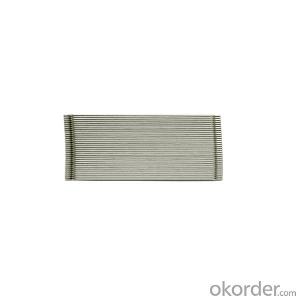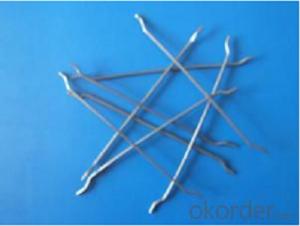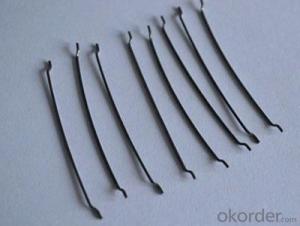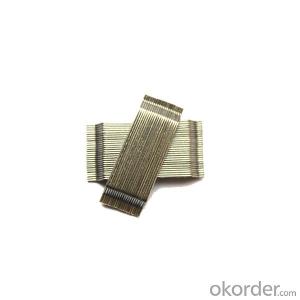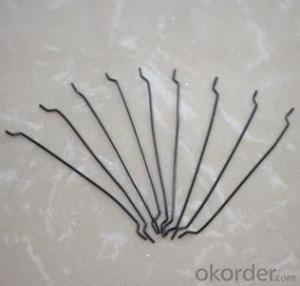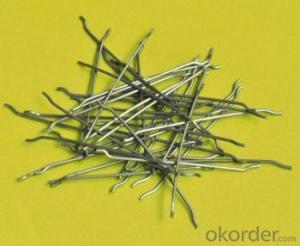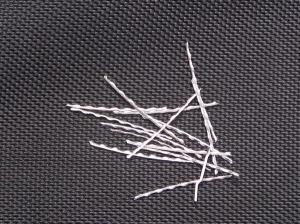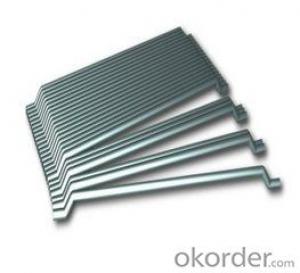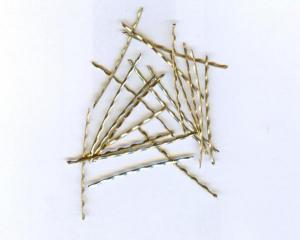Melt Extract Stainless Steel Fiber 0.9/50 Concrete Steel Fiber from CNBM China
- Loading Port:
- Tianjin
- Payment Terms:
- TT OR LC
- Min Order Qty:
- 1 m.t.
- Supply Capability:
- 5000 m.t./month
OKorder Service Pledge
Quality Product, Order Online Tracking, Timely Delivery
OKorder Financial Service
Credit Rating, Credit Services, Credit Purchasing
You Might Also Like
Quick Details
Place of Origin: Tianjin, China (Mainland)
Model Number: 0.9
Material: Steel
Production Process: Cold drawn
Lengh: 50
Type: 1
Compressive Strength: >1200MPa
Aspect ratio: 56
Standard: ASTM A820M-11
Section Shape: Circular
Application: Concrete Reinforcement
Packaging & Delivery
| Packaging Details: | 20 kg/Bag,50 bags/Pallet or 1,000kg/ Bulk Bag |
|---|---|
| Delivery Detail: | 1 Month |
Product Description
| Diameter | 0.90 | mm | 0.04 | in |
| Length | 50.00 | mm | 1.96 | in |
| Aspect Ratio | 56 | |||
| Tensile strength | 1200 MPa | |||
| Type | Cold drawn Steel Fiber | |||
| End | Hooked-end Steel Fiber | |||
| Glued/Loose | Glued Steel Fiber | |||
| Bending Angle | 45°(min.30°) | |||
| Usage & Performance | Floor:Trafficked areas and Industrial floors | |||
| Shotcrete :Slope stabilization and Final lining | ||||
| Precast concrete:Pipe and Railway sleepers | ||||
| Packing | Standard Export Pallet Packing | Bag Packing | 20 kg/Bag,50 bags/Pallet | |
| Bulk Packing | 1,000kg/ Bulk Bag | |||
| Loading Quantity | 20’GP | 20-25 Tonne/Tonnes | ||
| 40’GP | 25-27 Tonne/Tonnes | |||
| 40’HQ | 25-27 Tonne/Tonnes | |||
| MOQ | 1 kg for trial order | |||
| Supply Ability | 10,000 Tonne/Tonnes per Year | |||
| Payment Terms | T/T or L/C at sight | |||
| Delivery Time | Within 15 days after receiving deposit or original L/C at sight | |||
| Certification | ISO9001:2000, CE, | |||
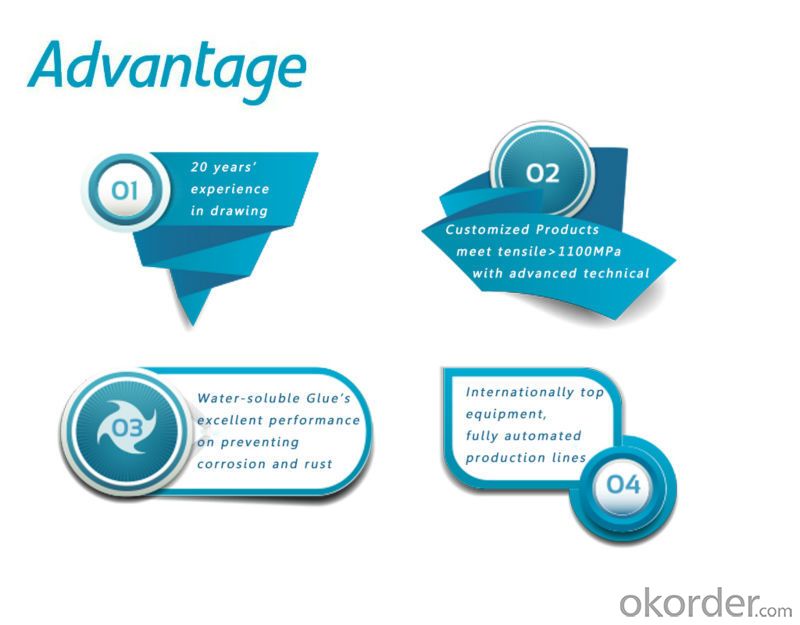
| Product | Diameter | Length mm/in | Aspect Ratio | Type | Packing |
| G-6030 | 0.5 mm (0.0197 in) | 30 mm (1.1811 in) | 60 | Glued | 20 kg/Bag, or 1,000kg/ Bulk Bag |
| G-6535 | 0.55 mm (0.0217 in) | 35 mm (1.3780 in) | 65 | Glued | 20 kg/Bag, or 1,000kg/ Bulk Bag |
| G-6035 | 0.6 mm (0.0236 in) | 35 mm (1.3780 in) | 60 | Glued | 20 kg/Bag, or 1,000kg/ Bulk Bag |
| G-8060 | 0.75 mm (0.0295 in) | 60 mm (2.3622 in) | 80 | Glued | 20 kg/Bag, 50 bags/Pallet |
| G-6060 | 0.9 mm (0.0354 in) | 60 mm (2.3622 in) | 60 | Glued | 20 kg/Bag, 50 bags/Pallet |
| G-6030 | 0.5 mm (0.0197 in) | 30 mm (1.1811 in) | 60 | Loose | 20 kg/Bag, or 1,000kg/ Bulk Bag |
| G-6535 | 0.55 mm (0.0217 in) | 35 mm (1.3780 in) | 65 | Loose | 20 kg/Bag, or 1,000kg/ Bulk Bag |
| G-6035 | 0.6 mm (0.0236 in) | 35 mm (1.3780 in) | 60 | Loose | 20 kg/Bag, or 1,000kg/ Bulk Bag |
| G-8060 | 0.75 mm (0.0295 in) | 60 mm (2.3622 in) | 80 | Loose | 20 kg/Bag, 50 bags/Pallet |
| G-6060 | 0.9 mm (0.0354 in) | 60 mm (2.3622 in) | 60 | Loose | 20 kg/Bag, 50 bags/Pallet |
- Q: Is melt extract stainless steel fiber compatible with all types of admixtures?
- No, melt extract stainless steel fiber may not be compatible with all types of admixtures. Compatibility depends on the specific type of admixture and its chemical composition, as well as the intended application. It is important to consult with experts or manufacturers to determine the compatibility before usage.
- Q: Is melt extract stainless steel fiber compatible with all types of concrete curing methods?
- No, melt extract stainless steel fiber may not be compatible with all types of concrete curing methods.
- Q: How does the addition of melt extract stainless steel fiber impact the shrinkage of concrete?
- The addition of melt extract stainless steel fiber can have a significant impact on the shrinkage of concrete. Stainless steel fibers are added to concrete to enhance its strength, durability, and crack resistance. When these fibers are incorporated into the concrete mix, they provide reinforcement and reduce the overall shrinkage of the material. Concrete shrinkage is a natural phenomenon that occurs as the material dries and loses moisture. This shrinkage can lead to the development of cracks, which can compromise the integrity and longevity of the concrete structure. However, by adding melt extract stainless steel fibers, the shrinkage is mitigated, and the potential for cracks is greatly reduced. The stainless steel fibers work by creating a three-dimensional network within the concrete matrix. As the concrete shrinks, the fibers resist the tensile forces that develop, preventing the formation of cracks. The fibers act as reinforcement, distributing the stress throughout the material and improving its overall performance. Furthermore, the addition of melt extract stainless steel fibers can also enhance the post-cracking behavior of concrete. In the event that cracks do occur, the fibers provide bridging reinforcement across the cracks, preventing them from propagating further and improving the structural integrity of the concrete. Overall, the addition of melt extract stainless steel fibers to concrete results in a significant reduction in shrinkage and an improvement in crack resistance. This not only enhances the durability and longevity of the concrete structure but also ensures its ability to withstand external forces and environmental conditions.
- Q: Can melt extract stainless steel fiber be used in bridge deck applications?
- Yes, melt extract stainless steel fiber can be used in bridge deck applications. Melt extract stainless steel fiber is a type of reinforcement that is commonly used in concrete structures, including bridge decks. It is known for its high tensile strength, corrosion resistance, and durability, making it an ideal choice for applications where the structure is exposed to harsh environmental conditions, such as bridges. The stainless steel fibers are typically added to the concrete mixture, providing additional strength and crack resistance to the bridge deck. Additionally, melt extract stainless steel fiber can help improve the overall performance and lifespan of the bridge deck by reducing shrinkage, minimizing cracking, and enhancing structural integrity. Therefore, it is a suitable and commonly used reinforcement material for bridge deck applications.
- Q: Can melt extract stainless steel fiber be used in refractory applications?
- Yes, melt extract stainless steel fiber can be used in refractory applications. Stainless steel fibers are known for their high temperature resistance and excellent mechanical properties, making them suitable for use in refractory materials. These fibers can improve the strength, thermal shock resistance, and overall performance of refractory products. They are commonly used in applications such as furnace linings, kiln furniture, and thermal insulation. The melt extract process ensures that the stainless steel fibers have a uniform composition and structure, enhancing their performance and durability in high-temperature environments. Overall, melt extract stainless steel fiber is a valuable addition to refractory materials, providing enhanced thermal and mechanical properties.
- Q: Can melt extract stainless steel fiber be used in precast concrete applications?
- Yes, melt extract stainless steel fiber can be used in precast concrete applications. These fibers are commonly added to concrete mixes to enhance their mechanical properties and improve structural integrity. The stainless steel fibers provide reinforcement and increase the tensile strength of the concrete, preventing cracking and enhancing its durability. Additionally, stainless steel fibers are corrosion-resistant, making them suitable for use in precast concrete applications where exposure to moisture or chemicals is a concern. Overall, using melt extract stainless steel fiber in precast concrete can improve the performance and longevity of the structures.
- Q: Does melt extract stainless steel fiber improve the resistance to chloride penetration of concrete?
- Yes, melt extract stainless steel fiber can improve the resistance to chloride penetration of concrete. The addition of stainless steel fibers to concrete helps to enhance its durability and reduce the risk of chloride ingress, which can lead to corrosion of reinforcement and structural deterioration. The steel fibers act as a barrier, preventing the penetration of chloride ions into the concrete matrix, thereby improving its resistance to chloride attack.
- Q: How does melt extract stainless steel fiber improve the crack width control in concrete?
- Melt extract stainless steel fiber serves as a reinforcement for concrete, aiming to enhance its crack width control. By incorporating these fibers, the stress and load distribution within the concrete become more uniform, effectively hindering crack formation and propagation. The prominent advantage of melt extract stainless steel fiber lies in its capacity to augment the flexural strength of concrete. Consequently, it becomes more resilient against heavy loads and stresses, preventing any potential cracking. Acting as miniature reinforcements, the fibers act as bridges across cracks, thereby inhibiting their expansion. Moreover, melt extract stainless steel fibers exhibit remarkable resistance to corrosion, a prevalent issue in concrete structures. The occurrence of corrosion often results in the expansion of steel reinforcements and subsequent concrete cracking. Utilizing stainless steel fibers significantly mitigates the risks associated with corrosion-related cracking. Additionally, the inclusion of melt extract stainless steel fibers in concrete elevates its durability and longevity. These fibers enhance the overall toughness of the concrete, rendering it more resistant to impact, abrasion, and fatigue. Consequently, the damage inflicted by external forces is minimized, thus controlling crack width. To summarize, melt extract stainless steel fiber enhances crack width control in concrete by fortifying its flexural strength, reducing the likelihood of corrosion-related cracking, and augmenting its durability. By preventing crack expansion and minimizing the formation of new cracks, these fibers significantly contribute to the integrity and longevity of concrete structures.
- Q: What is the effect of melt extract stainless steel fiber on the toughness of concrete?
- Adding melt extract stainless steel fiber to concrete can result in a positive impact on its toughness. Typically, stainless steel fibers are utilized as reinforcement in concrete to enhance its mechanical properties, specifically its toughness. When incorporated into concrete, these fibers function as tiny reinforcements that aid in the distribution of stress and the prevention of cracking. Through this reinforcement, the concrete's overall toughness is improved, rendering it more resistant to external forces such as impacts, vibrations, and other types of stress. The effectiveness of melt extract stainless steel fibers in enhancing toughness lies in their remarkable strength and durability. Being resistant to corrosion, these fibers ensure their long-term effectiveness in concrete structures. Moreover, their small size and high aspect ratio contribute to a stronger bond between the fibers and the surrounding matrix, further enhancing the concrete's overall toughness. In summary, the addition of melt extract stainless steel fiber to concrete elevates its toughness, resulting in improved resilience and durability. This proves particularly advantageous in scenarios where concrete is subjected to heavy loads, dynamic forces, or harsh environmental conditions.
- Q: Can melt extract stainless steel fiber be used in the construction of offshore platforms?
- Yes, melt extract stainless steel fiber can be used in the construction of offshore platforms. It is a durable and corrosion-resistant material that can enhance the strength and integrity of the structure, making it suitable for harsh marine environments.
Send your message to us
Melt Extract Stainless Steel Fiber 0.9/50 Concrete Steel Fiber from CNBM China
- Loading Port:
- Tianjin
- Payment Terms:
- TT OR LC
- Min Order Qty:
- 1 m.t.
- Supply Capability:
- 5000 m.t./month
OKorder Service Pledge
Quality Product, Order Online Tracking, Timely Delivery
OKorder Financial Service
Credit Rating, Credit Services, Credit Purchasing
Similar products
Hot products
Hot Searches
Related keywords
